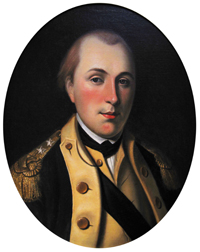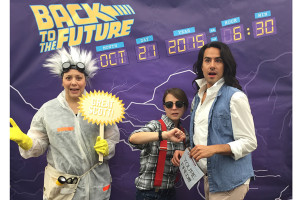
Sarah Vowell is everywhere these days. The journalist, humorist, social commentator, and New York Times bestselling author is a late-night talk show regular whose distinctive voice can be heard on NPR’s This American Life and in numerous TV and film projects, including the hit animated film, The Incredibles. Vowell sat down with American Libraries in June to discuss her latest book, Lafayette in the Somewhat United States, a funny and perceptive account of the Marquis de Lafayette’s impact, teaching history, and the vital role that libraries played in her youth. Vowell appeared at the Chicago Humanities Festival on October 29.
The Marquis de Lafayette, a French aristocrat who fought for the US in the American Revolutionary War, is a ubiquitous but overlooked character in American history. He touched many significant events, people, and places: the Revolution, Herman Melville, Marie Antoinette, and also our modern parks, cities, and roads. The name “Lafayette” is everywhere in the US, but many people don’t know why. Why did you decide to write about him? What drew him to you?
SARAH VOWELL: The book was a few years in the making. I wrote a short piece quite a number of years ago about Lafayette’s return trip to the United States in 1824. He was invited by President Monroe to come celebrate the 50th anniversary of American independence. He was the last living general of the Continental Army, so he was kind of the symbol of the Revolution in a time when all the original patriots were either dead or dying off. Jefferson and Adams would be dead within two years. Washington had been gone awhile.
What caught my attention was: I was at Arrowhead, Herman Melville’s house in the Berkshire Mountains where he wrote Moby Dick, and on display in the house was this little baby girl’s silk dress. It was Melville’s wife’s when she was a baby, and it was the dress she wore to be presented to Lafayette in 1824. I thought, “Huh, I didn’t know Lafayette was here in 1824.” So I started researching that trip. It was a euphoric, 13-month victory lap of the then-24 states.
When Lafayette came to America, I think 80,000 people greeted his boat in New York Harbor, and the population of New York City then was around 120,000. Every night was a party, and he was thronged for over a year. He was this huge, huge celebrity. He seems sort of forgotten now as a person. He turned into a place probably because of that trip; people started naming things after him because he was basically the only person who had been to all of the states in 1824. Towns and counties and streets and parks and children and horses and ships. He’s basically remembered as the name now for all these things.
When I was researching this story, it was around the “freedom fries” era, when people were upset with the French for not being onboard with the American invasion of Iraq. And then a few years later, I was in Paris giving a talk at the American embassy, and I realized how much affection I had for [Lafayette] and remembered how much affection Americans used to have for him. He was the symbol of the French alliance.
When the United States came to France during World War I to help our old allies, they marched the expeditionary forces under Gen. Pershing. When they got to Paris, they marched straight to Lafayette’s grave, and an officer gave this speech about how America was there to help France. And that speech ended with him saying, “Lafayette, we are here.”
For so long in our history, Lafayette was France. And France was our great ally. And so it kind of spun into this book that has a lot of contextual digressions, I guess you could call them, where I talk about the French alliance itself. Not just Lafayette but how the United States could not have won the Revolutionary War without French help—without their money, without their soldiers and sailors, without their equipment, without their gunpowder. We owed them. And Lafayette is kind of the most charismatic symbol of that.

by Charles Willson Peale, 1779-80
Much like Lafayette’s tour around the US, the book itself is a journey. It chronicles your travels around the country as you learn about Lafayette. Were you a student of history growing up? Was it something you loved as a child, or did you come to history later in life through your travels and other serendipitous moments?
I came to writing about history professionally fairly late—I was maybe in my late 20s the first time I tried it. I was always interested in history partly, I think, because of my family. Some people feel divorced from history because it seems like something that happens to other people. But I think for my family–because I have Cherokee ancestors who were on the Trail of Tears; I have a Revolutionary War soldier ancestor; my uncle was in World War II; “Pretty Boy” Floyd came to my grandparent’s house and had dinner and left $20 under the dinner plate—history was always talked about anecdotally, as something that had happened to our grandparents and grandparents’ grandparents. It was always part of something that was discussed.
Going to historic sites was part of the family vacation agenda. But when I started out as an arts writer and critic, and when I wrote a book about radio, and when I started writing for a radio show in the 1990s about various things, mostly the arts still, and I made a documentary about the Trail of Tears, where I drove the Trail of Tears just because it was part of my family history, and I wanted to physically experience that journey—that was it. That changed things for me, because I fell in love with the whole process. I was writing about it but also researching and going to places and seeing what had changed and what remained.
And also, it seems like Americans are a little underinformed about their history. I think in 2009 there was a survey of American adults conducted by the American Revolution Center. I can’t remember the numbers, but a majority didn’t know what century the American Revolution took place. A majority thought the Civil War took place before the Revolutionary War, and more of them knew that Michael Jackson wrote “Beat It” than that the Bill of Rights is part of the Constitution. So, that I find dispiriting, and I guess this is my little contribution to do something about that because, ignorance: bad.
Also, besides that fact, I think that some of this is important to know about as citizens. It’s also just so fascinating. I write books for the general reader; I’m not some kind of scholar. Knowing that for some of my readers this is going to be the only book they read on the Revolution, I think it kind of broadened the scope of the book a little bit. At every point, wherever I’m trying to locate this one swashbuckling Frenchman on horseback on any given battle or city or wherever, I’m always providing the historical context of what’s going on that got him there, and how the Army got there, or what the politicians are doing behind the Army’s back or whatever. So I think the book has about at least two layers that way.
Yes, it’s a history book but it’s not a “history book.” I put “history book” in quotes because I think when people hear that phrase, they get frightened. History scares some people, unfortunately. I think books like yours, that do provide context, are important. What are your thoughts on this book being taught in schools, as a supplement to history books that can be dry to read?
I don’t mind being homework. I don’t think textbooks—I’m sure there are some good ones, and I’m not an expert on this, but I remember when I was going through school and college, the books that had an impact on me were “book books.” I do think of myself as a writer, not as a historian. I think of myself as a nonfiction writer, and it’s sort of this genre that’s kind of in between journalism and straight history and art. Because I’m still bound to the facts; I can’t just make stuff up. But there are still a few more shenanigans, I would say.
I sometimes go off topic a little bit if I meet an interesting person or if something interesting happens. There are certain things about going to historic sites that open the story up; there’s no way I can control that. I think sometimes maybe more traditional historians, they have the story they want to tell, and that’s what they do. If I have an inkling, a little glimmer of what I want to do, and I just go out and see what happens. And so the book is maybe that way because I just go to actual places and talk; I’ll learn something anywhere from anyone, anyhow. I don’t know need to learn everything in an archive. I can learn from an old guide in the town. I can look out a car window and see a sign or whatever. I see history as not something that just happened in the past and is over; it has reverberations in the present. I think it’s important to me to grab onto these little glimmers where I can.

What role did libraries have in the creation of this book and in your life growing up?
When I said that, for me, as a student growing up, textbooks weren’t particularly effective and the books that meant something were “book books,” I should mention that a lot of these book books I wasn’t reading in actual class—I was skipping school and going to my public library and hanging out in the stacks reading books when I was supposed to be in class.
My nephew is going to the high school I went to, and I can see it in him. Some of [high school] is valuable, but some of it is basically like, you need to imprison these kids somewhere, so here’s the building we’ve decided to do it. I would sneak out of my high school prison and go to the public library. And I remember, I was a musician as a kid, and I remember sitting on the floor, hiding in the stacks and reading this biography of John Coltrane. It was also during the Nancy Reagan “Just say no” era. And John Coltrane, whose music I loved, he was a junkie. And I’m sitting there reading this biography of a junkie. And stuff like that really gives you a more compassionate view of people, just thinking that here was this great artist who made this great art who was this very flawed person with this very disturbing problem. There was something about reading his biography that you can’t get from just listening to his music. You don’t know where he grew up or what his struggle was or what he was thinking. I mean, the music is the music, but I just remember the admiration I had for him was sort of reinforced. And I think I had more admiration for him knowing his story and knowing what he was going through. It was more complicated and more human and bigger that just “drugs bad, junkies bad.” That’s the kind of stuff we didn’t discuss in high school.
And so, it was a physical refuge to me, my town library. And especially I think because, until I was 11, I grew up in a town without any library. My school had no library. It had a shelf with some books on it. Because we lived out in the country and went to this country school. When I was 11, my family moved to this college town, and my sister and I loved two things—we loved books and we loved to roller-skate. And that first summer we were there in this college town, there were sidewalks, which we didn’t have out in the country, and there was a library. So every day we would roller-skate over to the public library.
We just couldn’t believe you could live some place where you could go to the library every single day, instead of having to make this long, long drive. It was really important to us because in our family—it’s not that books weren’t important; it was just that one book was important: the Bible. And it is an important book. But having this other place where you could discover all these new ideas and people that had nothing to do with you and your family necessarily—the physical place was important.
Also, sometimes I would skip school in winter and it was really warm in there. But it really is a part of who I am. And it influences how I write. It’s weird, it’s contradictory, but I don’t just think of learning as book learning, but I think the only way I learned that from was from books.


